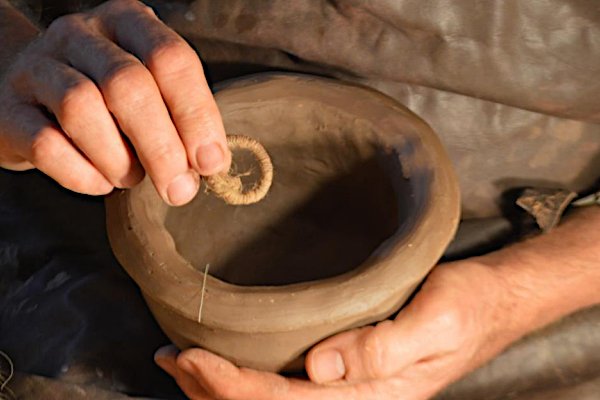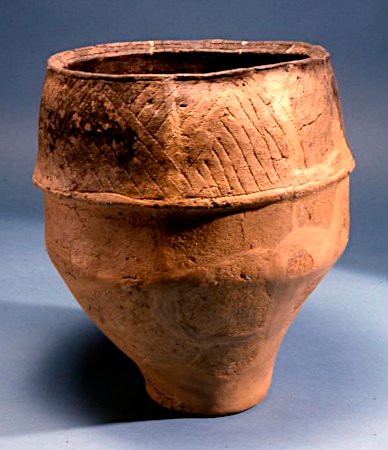Pre-Roman Pottery
Pottery first started being used in the British Isles during the “Neolithic” and some archaeologists think the original pots were copies of leather vessels. These have rounded bottoms and are often undecorated: this was the type of pottery found at the excavation in Berkshire from which the Horton house, at Butser, has been reconstructed.
By the later Neolithic the pottery has flat bases and was often (simply) decorated. This is known as Grooved Ware and appeared in the third millennium BC. These types of pots appear to originate in Orkney, and probably in response to the construction of houses with flat surfaces (shelves). It is Grooved Ware pottery that is found in the archaeology of Durrington Walls and Avebury, during the first phase of building at Stonehenge.
Metal in the form of Gold and Copper was first seen in Britain around about 2,500 BC and along with these new materials came the Beaker People. This marks the start of Bronze Age pottery in the British Isles. These people are named after the shape of pottery they made, rather than the pottery being named after the people.
Long-necked Beaker from Durrington, close to the Cursus at Stonehenge. The decoration is simple cross-hashing.
© The Wiltshire Museum
Beaker ware from different regions shared many characteristics. The pot on the left is from Sierentz in France and, on the right, a pot from Bathgate in Scotland.
©Anthony Denaire © National Museums Scotland
All pottery during this period was made and used by members of the household. There were no pottery industries or production centres such as those found during the Roman or medieval periods.
The first stage of production is relatively simple: Clay is mixed with water and rolled into a ball. ‘Temper’ is then added to aid construction, prevent shrinkage and cracking during the drying and firing of vessels, and to give the final pot some added resilience. Temper is a form of ‘impurity’ and various organic materials can be used, such as bone, shell, sand or even charcoal.
The pot itself is normally of a ‘coil’ construction. The pots begin as a simple ball of clay which is shaped into a shallow bowl. One or more long ‘sausages’ of clay are then coiled around on top of this shallow base to add height. This process is repeated multiple times.
This pottery is finely made and often decorated by “combing” the clay or by pressing cord into the clay:
The pots is then fired in a domestic hearth, bonfire or specially build pit, at temperatures of 600 to 800 degrees centigrade. The colour of the finished pot tells archaeologists something of how they were fired: Dark grey or ‘reduced’ pots are fired in an atmosphere where oxygen has been excluded whilst lighter, red or orange vessels are fired in an oxygen rich atmosphere.
The consistent firing and regular colours found in much prehistoric pottery indicates that ancient potters were skilled in controlling the firing conditions in which they produced their vessels.
A video showing how Grooved Ware pottery was made and fired.
As we move through the Bronze age we see different styles of vessel. Collared Urns spanned the period 2,200 BC to 1,500 BC, but were rarely found in settlement contexts and more commonly in burials, and as cremation urns in barrows. They are named for the prominent rim which forms a wide band or collar around the top of the vessel; they are often large and thick-walled with decoration around the rim top and collar only, whilst the lower body is plain.
Towards the end of the Bronze Age and into the Iron Age the quality and range of pottery seems to deteriorate markedly, particularly in Northern Britain. In some areas people seem to have abandoned its use entirely.
In the south of Britain we find the use of ‘grog’ (crushed remains of previous pots) being used as temper, with the final pots having less decoration: they are often found with rough, random incised scoring/scratching in a vertical, diagonal or arched pattern. This is thought to be practical in purpose, to aid handling, rather than as decoration.
An example of Scored Ware pottery, excavated by Peterborough Archaeology
As the Iron Age ended, the occurrence of pottery with continental influences is found, although very sparsely. There followed the import of fine Gaulish wheel made pottery and, with the full Roman invasion in 43 AD, and the potter’s wheel began to be used within Britain, itself.
Experimental archaeologists from the Bath and Camerton Archaeological Society demonstrating the process from start to finish.







